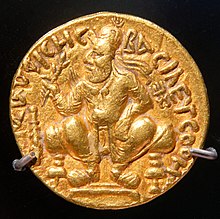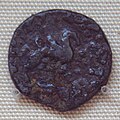|
Vima Kadphises
Statue of Vima Kadphises Vima Kadphises (or possibly Vima Takto)[2] on throne. The name of the ruler is mentioned in an epigraphic inscription at the feet of the statue. The inscription reads: Maharaja rajatiraja devaputra Kushanaputra (Shahi Vamataksha) masya Mathura Museum. Vima Kadphises (Greek: Οοημο Καδφιϲηϲ Ooēmo Kadphisēs (epigraphic); Kharosthi: 𐨬𐨁𐨨 𐨐𐨫𐨿𐨤𐨁𐨭 Vi-ma Ka-lpi-śa, Vima Kalpiśa) was a Kushan emperor from approximately 113 to 127 CE. According to the Rabatak inscription, he was the son of Vima Takto and the father of Kanishka. RuleGenealogyThe connection of Vima Kadphises with other Kushan rulers is described in the Rabatak inscription, which Kanishka wrote. Kanishka makes the list of the kings who ruled up to his time: Kujula Kadphises as his great-grandfather, Vima Taktu as his grandfather, Vima Kadphises as his father, and himself Kanishka: "... for King Kujula Kadphises (his) great grandfather, and for King Vima Taktu (his) grandfather, and for King Vima Kadphises (his) father, and *also for himself, King Kanishka" (Cribb and Sims-Williams 1995/6: 80) Emperor Vima Kadphises expanded the Kushan territory in Afghanistan and north-west India, where he may have replaced the Indo-Scythian ruler Sodasa in Mathura. Coins
He was the Kushan emperor to first introduce gold coinage, in addition to the existing copper and silver coinage. Most of the gold seems to have been obtained through trade with the Roman Empire. The gold weight standard of approximately eight grams corresponds to that of Roman coins of the 1st century. Gold bullion from Rome would be melted and used for the Kushan mints, into three denominations: the double stater, the stater, and the quarter starter (or dinara).[dubious – discuss] The usage of gold testifies to the prosperity of the Kushan Empire from the time of Vima, being the center of trade between the Han dynasty of China (where Vima was known as 阎膏珍), Central Asia and Alexandria and Antioch in the West. The Kushan were able to maintain and protect the Silk Road, allowing silk, spices, textiles or medicine[citation needed] to move between China, India and the West. In particular, many goods [vague] were sent by ship to the Roman empire, creating a return flow of gold coins, Greek wine and slaves. Works of arts were also imported from all directions[where?] [vague], as indicated by the variety and quality of the artefacts [vague] found in the Kushan summer capital of Bagram in Afghanistan. A strong artistic syncretism was stimulated, as indicated by the Greco-Buddhist art of Gandhara.[citation needed] Roman history relates the visit of ambassadors from the Indian kings to the court of Trajan (98–117 CE), bearing presents and letters in Greek, which were sent either by Vima Kadphises or his son Kanishka.[citation needed] Most of Vima's coins feature the Buddhist symbol of the Triratana on the reverse (or possibly Shiva's symbol for Nandi, the Nandipada), together with Hindu representations of Shiva, with or without his bull. Often time, a Trishul is depicted along with Shiva.[citation needed] Major coin legends of Vima Kadphises Vima Kadphises with ithyphallic Shiva. Obv: Bust of king emerging from a cloud, with a crested helmet and holding a club. Corrupted Greek language legend: ΒΑΣΙΛΕΥΣ ΟΟΗΜΟ ΚΑΔΦΙΣΗΣ ("Basileus Ooimo Kadphisis"): "King Vima Kadphises". Rev: Shiva, with a long trident in right hand, and the skin of a tiger in the left. Left, monogram of Vima Kadphises. Right: Buddhist triratna symbol (or possibly Nandipada). Kharoshthi legend: MAHARAJASA RAJADIRAJASA SARVALOGA ISVARASA MAHISVARASA VIMA KATHPHISASA TRADARA "The Great king, the king of kings, lord of the World, the Mahisvara (lord of the earth), Vima Kathphisa, the defender." Vima Kadphises in long coat. Legend in corrupted Greek script: ΒΑϹΙΛΕΥϹ BACIΛEWN CWTHP MEΓAC ΟΟΗΜΟ ΚΑΔΦΙϹΗϹ ("Basileus Basileuon Soter Megas Ooemo Kadphises"): "King of Kings Vima Kadphises the Great Saviour". British Museum. Coin types
Footnotes
References
External links |
|||||||||||||||||||||||||||||||||||||||||||||||||
Portal di Ensiklopedia Dunia


















